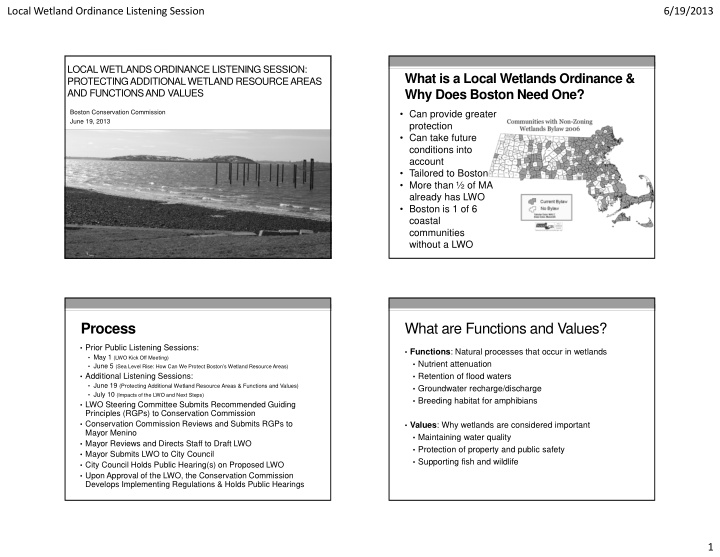



Local Wetland Ordinance Listening Session 6/19/2013 LOCAL WETLANDS ORDINANCE LISTENING SESSION: What is a Local Wetlands Ordinance & PROTECTING ADDITIONAL WETLAND RESOURCE AREAS AND FUNCTIONS AND VALUES Why Does Boston Need One? Boston Conservation Commission • Can provide greater June 19, 2013 protection • Can take future conditions into account • Tailored to Boston • More than ½ of MA already has LWO • Boston is 1 of 6 coastal communities without a LWO Process What are Functions and Values? • Prior Public Listening Sessions: • Functions : Natural processes that occur in wetlands • May 1 (LWO Kick Off Meeting) • Nutrient attenuation • June 5 (Sea Level Rise: How Can We Protect Boston’s Wetland Resource Areas) • Additional Listening Sessions: • Retention of flood waters • June 19 (Protecting Additional Wetland Resource Areas & Functions and Values) • Groundwater recharge/discharge • July 10 (Impacts of the LWO and Next Steps) • Breeding habitat for amphibians • LWO Steering Committee Submits Recommended Guiding Principles (RGPs) to Conservation Commission • Conservation Commission Reviews and Submits RGPs to • Values : Why wetlands are considered important Mayor Menino • Maintaining water quality • Mayor Reviews and Directs Staff to Draft LWO • Protection of property and public safety • Mayor Submits LWO to City Council • Supporting fish and wildlife • City Council Holds Public Hearing(s) on Proposed LWO • Upon Approval of the LWO, the Conservation Commission Develops Implementing Regulations & Holds Public Hearings 1
Local Wetland Ordinance Listening Session 6/19/2013 How are Wetland Functions and Values Protection of property Protected/Regulated? Values The value of wetlands is recognized in federal, state, and local Flood control wetland legislation that was enacted to protect these resources Functions • Clean Water Act Water storage (public interest review) Water retention • Wetlands Protection Act (protected interests) Characteristics of Depression wetland • Wetlands Ordinances Wetland Resource (additional protected interests) Areas Located within a floodplain What Functions & Values (or Interests) are Functions and Values Not Regulated Under the Currently Protected by the Wetlands Wetlands Protection Act Protection Act? • Climate Change and Sea Level • Flood control Rise • Storm damage prevention • Pollution prevention • Public and private water supply • Groundwater supply • Land containing shellfish • Fisheries • Wildlife habitat 2
Local Wetland Ordinance Listening Session 6/19/2013 Functions and Values Not Regulated Under the Functions and Values Not Regulated Under the Wetlands Protection Act Wetlands Protection Act • Climate Change • Climate Change and Sea Level and Sea Level Rise Rise • Recreation • Recreation • Aesthetics Functions and Values Not Regulated Under the Functions and Values Not Regulated Under the Wetlands Protection Act Wetlands Protection Act • Climate • Climate Change and Change and Sea Level Rise Sea Level Rise • Recreation • Recreation • Aesthetics • Aesthetics • Historical Values • Historical Values • Plant Species 3
Local Wetland Ordinance Listening Session 6/19/2013 What Resource Areas are Currently What are Wetland Resource Areas? Protected by the Act? • Wetland Resource Areas (or Areas Subject to Protection) • Coastal Resource Areas are Identified in the WPA Regulations. • Land Under the Ocean • Designated Port Areas • Coastal Beaches (including tidal flats) • Examples include BVW, Salt Marsh, 100 year Floodplain, Riverfront Area, Coastal Beach, Coastal Bank, etc. • Coastal Dunes • Barrier Beaches • Coastal Banks • With few exceptions, activities proposed in Wetland • Rocky Intertidal Shores Resource Area or within the 100 foot Buffer Zone Require • Salt Marshes & Ponds Review and Approval by the Conservation Commission. • Land Containing Shellfish • Anadromous/Catadromous Fish Runs • Land Subject to Coastal Storm Flowage (100 year floodplain) or Tidal Action What Resource Areas are Currently Resource Areas that Are Not Protected by Protected by the Act? the Act • Inland Resource Areas • Vernal Pools: Temporary bodies of fresh water that • Banks (of jurisdictional ponds and streams) provide habitat for • Bordering Vegetated Wetlands (freshwater wetlands) vertebrates & • Land Under Waterbodies and Waterways (of jurisdictional ponds and streams) invertebrates. • Bordering Land Subject to Flooding (100 year floodplain) • Isolated Land Subject to Flooding • Riverfront Area (25 feet in Boston) 4
Local Wetland Ordinance Listening Session 6/19/2013 Resource Areas that are Not Protected by the Act • Vernal Pools • Isolated Vegetated Wetlands Resource Areas that are Not Protected by Buffer Zones the Act • Area of land extending 100 feet horizontally outward from the • Vernal Pools boundary of certain wetlands resource areas. • Not all resource areas have buffer zones (e.g., LSCSF, LSTA, LUW, LSF, Riverfront Area) • Isolated • The Buffer Zone is not in itself a resource area. Rather it Vegetated represents the extent of the Commission’s jurisdiction where work Wetlands is regulated. • Under the Act the Commission imposes conditions to protect the • Certain functions and values (interests) of the adjacent resource areas. Intermittent Streams • Why do Buffer Zones need protection? • Maximize groundwater recharge; moderate flooding; slow runoff; enhance infiltration; trap pollutants; stabilize soil; reduce bank erosion. 5
Local Wetland Ordinance Listening Session 6/19/2013 Buffer Zones Questions & Concerns… • LWO can establish “Regulatory Buffer Zones” to allow adoption of performance standards. • Tailored to urban environment. http://www.cityofboston.gov/environment/Conservation/wetlands.asp stephanie.kruel@cityofboston.gov 6
Recommend
More recommend